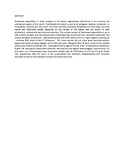| dc.contributor.author | Kerubo, LO | |
| dc.contributor.author | Midiwo, JO | |
| dc.contributor.author | Derese, S | |
| dc.contributor.author | Yenesew, A | |
| dc.contributor.author | Matthias, H | |
| dc.contributor.author | Peter, MG | |
| dc.contributor.author | Akala, HM | |
| dc.contributor.author | Eyase, F | |
| dc.contributor.author | Waters, N C | |
| dc.contributor.author | Kabaru, J | |
| dc.date.accessioned | 2015-04-01T09:57:07Z | |
| dc.date.available | 2015-04-01T09:57:07Z | |
| dc.date.issued | 2009 | |
| dc.identifier.citation | Kerubo, LO., Midiwo, JO., Derese, S., Yenesew, A., Matthias, H., Peter, MG., Akala, HM., Eyase, F., Waters, N C., Kabaru , J (2009). Phytochemical investigation of surface exudates of dodonaea angustifolia for in vitro antiplasmodial and mosquito larvicidal activity. 13th NAPRECA symposium book of abstracts pg. 35 August 10-14, 2009 | en_US |
| dc.identifier.uri | http://chemistry.uonbi.ac.ke/sites/default/files/cbps/sps/chemistry/13napreca2009.pdf | |
| dc.identifier.uri | http://hdl.handle.net/11295/81872 | |
| dc.description.abstract | Dodonaea angustifolia
in study belongs to the fami
ly sapindaceae distributed in the
tropical and subtropical regions of the world. Traditionally this plant is used as an
analgesic, laxative, antipyretic, in rheumatism, eczema, and skin ulcers. The most
common secondary metabolites of these plants are terp
enoids and flavonoids
usually deposited on the surface of the leaves, and are known to have antioxidant,
antibacterial and antiviral activities. The surface exudes of
Dodonaea angustifolia
is
up
to 12% surface exudates and has yielded seven methylated flav
onoids and two
clerodane terpenoids. The surface exudates showed anti
-
plasmodial activity with
IC50 values of 41.5
3.9
g/ml against chloroquine
-
sensitive (D6) strain of the
P.
falciparum
. The crude extract did not show good larvicidal activity, against
the larvae
of
Aedes aegypti,
as its LC50
value was > 60 μg/ml after 24 hours.
Most of the
isolated compounds showed moderate anti
-
plasmodial activity against the D6 strain
of
Plasmodium falciparum
(Table 1.0). Among the compounds tested for larvicidal
acti
vity against
Aedes aegypti;
rhamnocitrin (
5
) and santin (
4
) showed good dose
dependent activity with an LC50 value of 1.75 and 5.1
g/ml (Table 1.0), respectively,
after 24 hours.
In this presentation the chemistry, antiplasmodial and mosquito larvicidal
activity of
some isolated compounds will be discussed | en_US |
| dc.language.iso | en | en_US |
| dc.publisher | University of Nairobi | en_US |
| dc.title | Phytochemical investigation of surface exudates of dodonaea angustifolia for in vitro antiplasmodial and mosquito larvicidal activity | en_US |
| dc.type | Presentation | en_US |
| dc.type.material | en | en_US |

